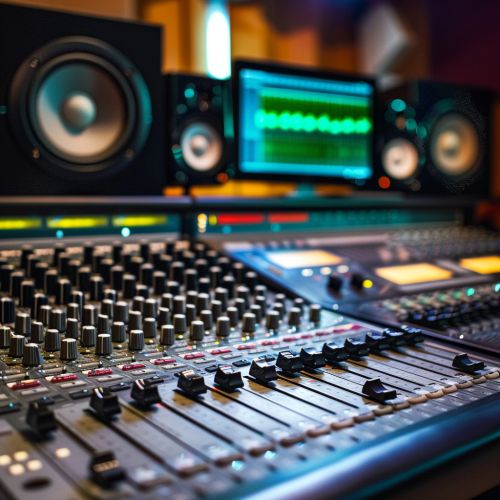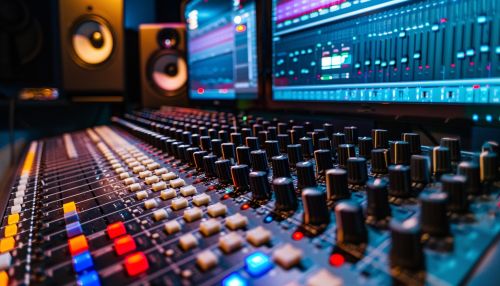Digital Audio Signal
Introduction
Digital audio signal refers to the representation of sound in a form that can be processed, stored, and transmitted by digital systems. This involves converting an analog audio signal into a digital format through a process known as analog-to-digital conversion (ADC). The digital audio signal is characterized by discrete values that represent the amplitude of the sound wave at specific intervals.
Analog-to-Digital Conversion
Analog-to-digital conversion is the process of converting continuous analog signals into a digital format. This involves sampling the analog signal at regular intervals and quantizing the amplitude values into discrete levels. The key parameters in ADC are the sampling rate and bit depth.
Sampling Rate
The sampling rate, measured in Hertz (Hz), defines the number of samples taken per second. According to the Nyquist-Shannon sampling theorem, the sampling rate must be at least twice the highest frequency present in the analog signal to accurately reconstruct the original sound. Common sampling rates include 44.1 kHz for CD quality audio and 48 kHz for professional audio applications.
Bit Depth
Bit depth determines the number of bits used to represent each sample. Higher bit depths provide greater dynamic range and lower quantization noise. Common bit depths include 16-bit for CD quality audio and 24-bit for professional audio applications.
Digital Audio Formats
Digital audio can be stored in various formats, each with its own characteristics and use cases. These formats can be broadly categorized into uncompressed, lossless compressed, and lossy compressed formats.
Uncompressed Formats
Uncompressed formats store audio data without any compression, preserving the original quality of the audio signal. The most common uncompressed format is WAV (Waveform Audio File Format), which is widely used in professional audio applications.
Lossless Compressed Formats
Lossless compressed formats reduce the file size without losing any audio information. These formats use algorithms to compress the data and then decompress it to its original form during playback. Examples include FLAC (Free Lossless Audio Codec) and ALAC (Apple Lossless Audio Codec).
Lossy Compressed Formats
Lossy compressed formats achieve higher compression ratios by discarding some audio information, which may result in a loss of quality. These formats are commonly used for streaming and portable audio devices. Examples include MP3 (MPEG-1 Audio Layer III) and AAC (Advanced Audio Coding).
Digital Signal Processing
Digital signal processing (DSP) involves manipulating digital audio signals to achieve desired effects or enhancements. DSP techniques are used in various applications, including audio editing, mixing, and mastering.
Filtering
Filtering is the process of removing or enhancing specific frequency components of an audio signal. Common types of filters include low-pass, high-pass, band-pass, and band-stop filters. These filters can be implemented using digital algorithms to achieve precise control over the audio signal.
Equalization
Equalization (EQ) involves adjusting the amplitude of specific frequency bands to shape the overall tonal balance of the audio signal. EQ is commonly used in audio production to enhance the clarity and presence of different elements in a mix.
Dynamic Range Compression
Dynamic range compression reduces the difference between the loudest and quietest parts of an audio signal. This is achieved by attenuating the amplitude of loud sounds and boosting the amplitude of quiet sounds. Compression is widely used in music production to achieve a more consistent and polished sound.
Digital Audio Transmission
Digital audio signals can be transmitted over various media, including wired and wireless connections. Common transmission protocols include S/PDIF (Sony/Philips Digital Interface), AES/EBU (Audio Engineering Society/European Broadcasting Union), and Bluetooth.
S/PDIF
S/PDIF is a digital audio interface used to transmit audio signals between devices. It supports both optical and coaxial connections and is commonly used in consumer audio equipment.
AES/EBU
AES/EBU is a professional digital audio interface used in studio and broadcast environments. It uses balanced XLR connectors and supports higher bit depths and sampling rates compared to S/PDIF.
Bluetooth
Bluetooth is a wireless technology used for short-range audio transmission. It supports various audio codecs, including SBC (Subband Coding) and aptX, to achieve different levels of audio quality and latency.
Applications of Digital Audio
Digital audio signals are used in a wide range of applications, from consumer electronics to professional audio production.
Consumer Electronics
Digital audio is an integral part of consumer electronics, including smartphones, tablets, and home entertainment systems. These devices use digital audio signals for playback, recording, and communication.
Professional Audio Production
In professional audio production, digital audio signals are used for recording, editing, mixing, and mastering music and other audio content. Digital audio workstations (DAWs) and audio interfaces are essential tools in this field.
Broadcasting
Digital audio signals are used in radio and television broadcasting to deliver high-quality audio content to listeners and viewers. Digital broadcasting standards, such as DAB (Digital Audio Broadcasting) and HD Radio, provide improved audio quality and additional features compared to analog broadcasting.
Future Trends in Digital Audio
The field of digital audio continues to evolve, driven by advancements in technology and changing consumer preferences.
High-Resolution Audio
High-resolution audio refers to audio files with higher sampling rates and bit depths than standard CD quality. This trend is gaining popularity among audiophiles who seek the highest possible audio fidelity.
Spatial Audio
Spatial audio technologies, such as Dolby Atmos and DTS:X, create immersive listening experiences by simulating three-dimensional soundscapes. These technologies are being adopted in home entertainment systems, cinemas, and virtual reality applications.
Artificial Intelligence
Artificial intelligence (AI) is being used to develop new tools and techniques for digital audio processing. AI-powered algorithms can enhance audio quality, automate editing tasks, and even generate music.


